
New episode out now! Learn about John Cabot, an Italian sailor who explored for England, and Amerigo Vespucci, whom the Americas are (tbh, unfairly) named after: open.spotify.com/episode/0RoL...
19.05.2025 21:22 — 👍 0 🔁 0 💬 0 📌 0@aahp.bsky.social
Hello, and thanks for joining us. We’re Another American History Podcast, or AAHP for short, and we’d love to walk you through some of Americans most famous, and infamous, moments. Find us on Spotify!

New episode out now! Learn about John Cabot, an Italian sailor who explored for England, and Amerigo Vespucci, whom the Americas are (tbh, unfairly) named after: open.spotify.com/episode/0RoL...
19.05.2025 21:22 — 👍 0 🔁 0 💬 0 📌 0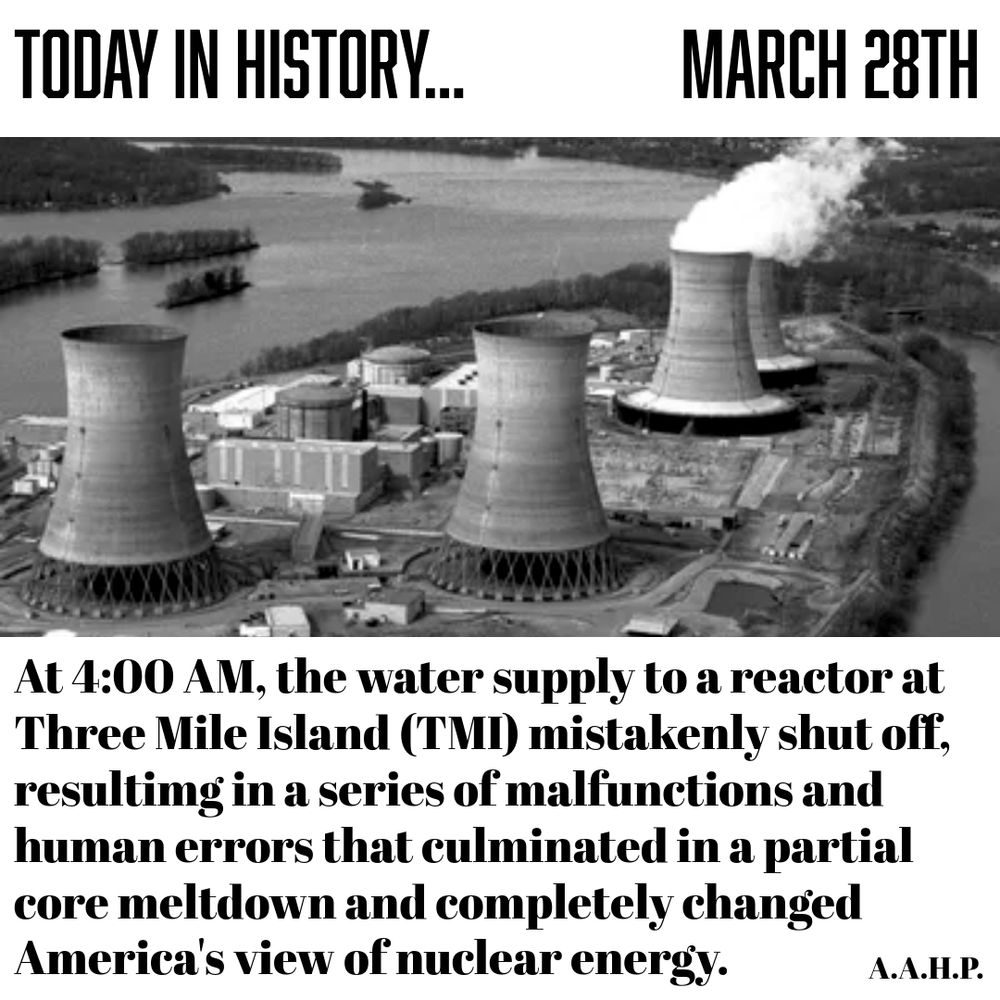
It was very nearly a much worse disaster. #threemileisland #tmi #nuclear #nuclearpower #history #americanhistory
It was very nearly a much worse disaster. #threemileisland #tmi #nuclear #nuclearpower #history #americanhistory
28.03.2025 19:22 — 👍 0 🔁 0 💬 0 📌 0
A today in history post about LBJ ordering the Alabama National Guard to escort a civil rights march from Selma to Montgomery
It was one of many marches and demonstrations which defined the era and helped shaped the civil rights movement as it is remembered today. #civilrights #selmamontgomerymarch #civilrightsmovement #history #americanhistory
20.03.2025 23:11 — 👍 0 🔁 0 💬 0 📌 0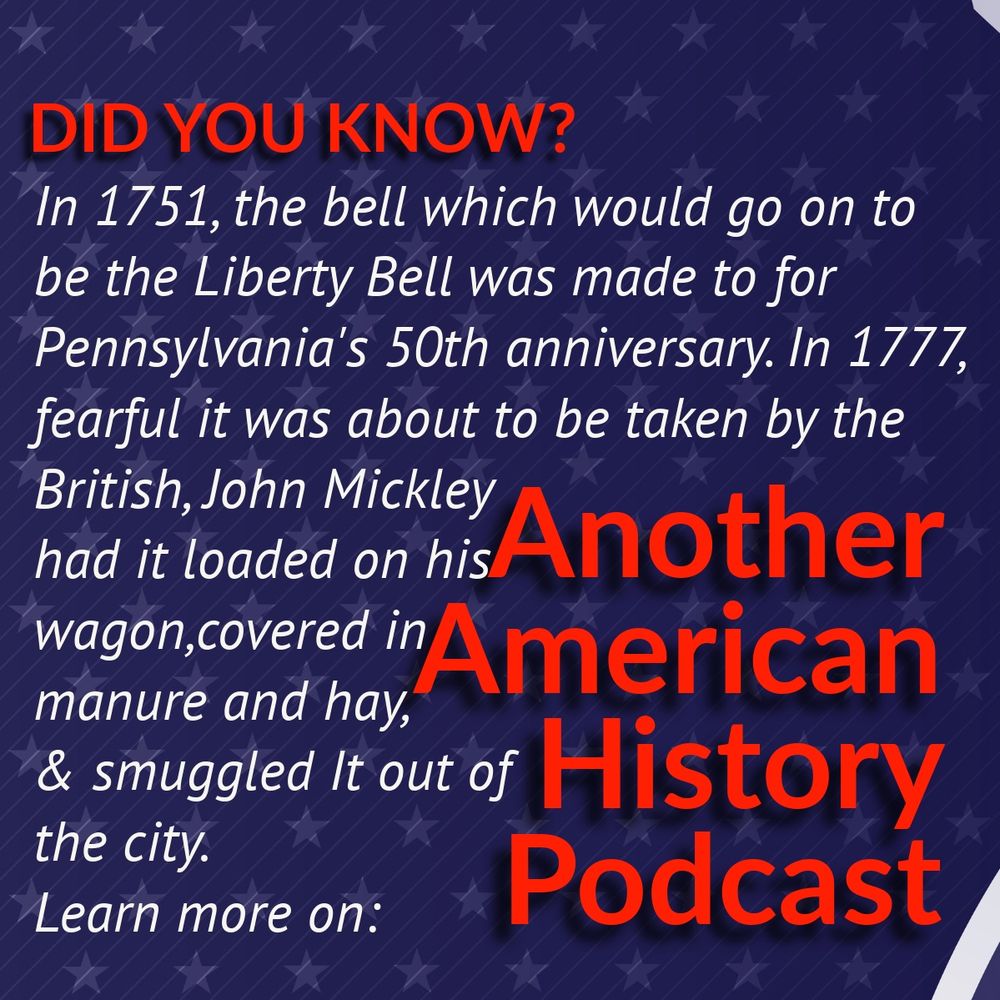
A brief history of the Liberty Bell’s creation and being saved during the American Revolution.
It may have smelled a little, but it was safe. #libertybell #philadelphia #history #americanhistory #podcast
19.03.2025 17:23 — 👍 2 🔁 0 💬 0 📌 0Them being white Anglo-Saxon Protestants does not, in my opinion, separate them in any meaningful way. They weren’t the first settlers, or the first successful ones, simply the ones later generations of influential people identified with the most. I’d love to hear your take on it though!
05.03.2025 20:03 — 👍 0 🔁 0 💬 1 📌 0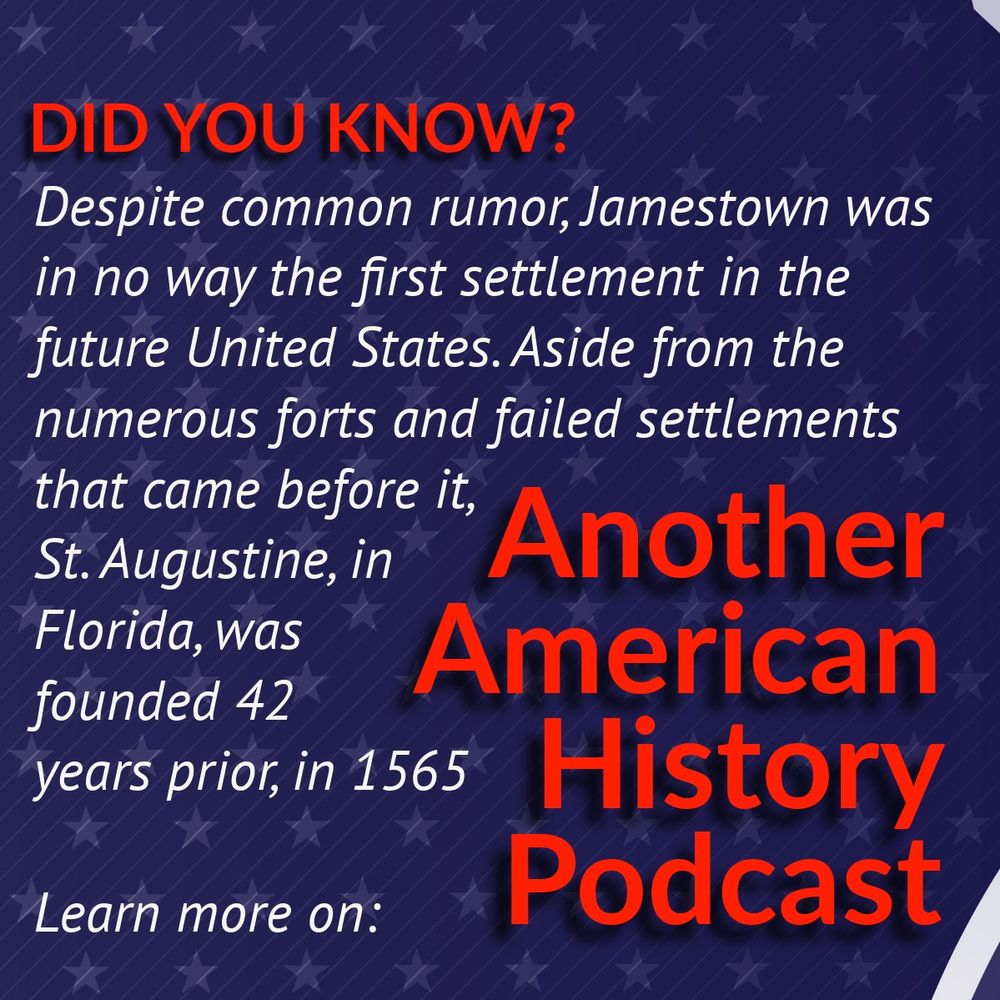
Jamestown is not the first successful settlement in continental US territory, though the tour guides there will still lie to your face about it
Not that Jamestown would ever admit it.
#history #americanhistory #jamestown #staugustineflorida #colonization

It only lasted two months. #history #americanhistory #slaverebellion #slavery
It only lasted two months.
#history #americanhistory #slaverebellion #slavery

An ad for Ep. 3 of AAHP
New episode, out today! Join us as we finish our journey with Columbus as he finishes his voyage, returns to Spain, makes several more trips, is imprisoned, and tries to sail around the world. Yeah, it’s a lot - see you there!
#columbus #columbusday #history #ColumbusDay #americanhistory
Seems particularly relevant given the recently discussed SAVE act
#saveact #save #womensrights #sufferage #vote #voting #votingrights #history #americanhistory
History is repeating itself.
There were more LGBTQ people removed from government during the lavender scare than were suspected communists during the red scare. They only really taught the latter in history classes.
en.wikipedia.org/wiki/Lavende...
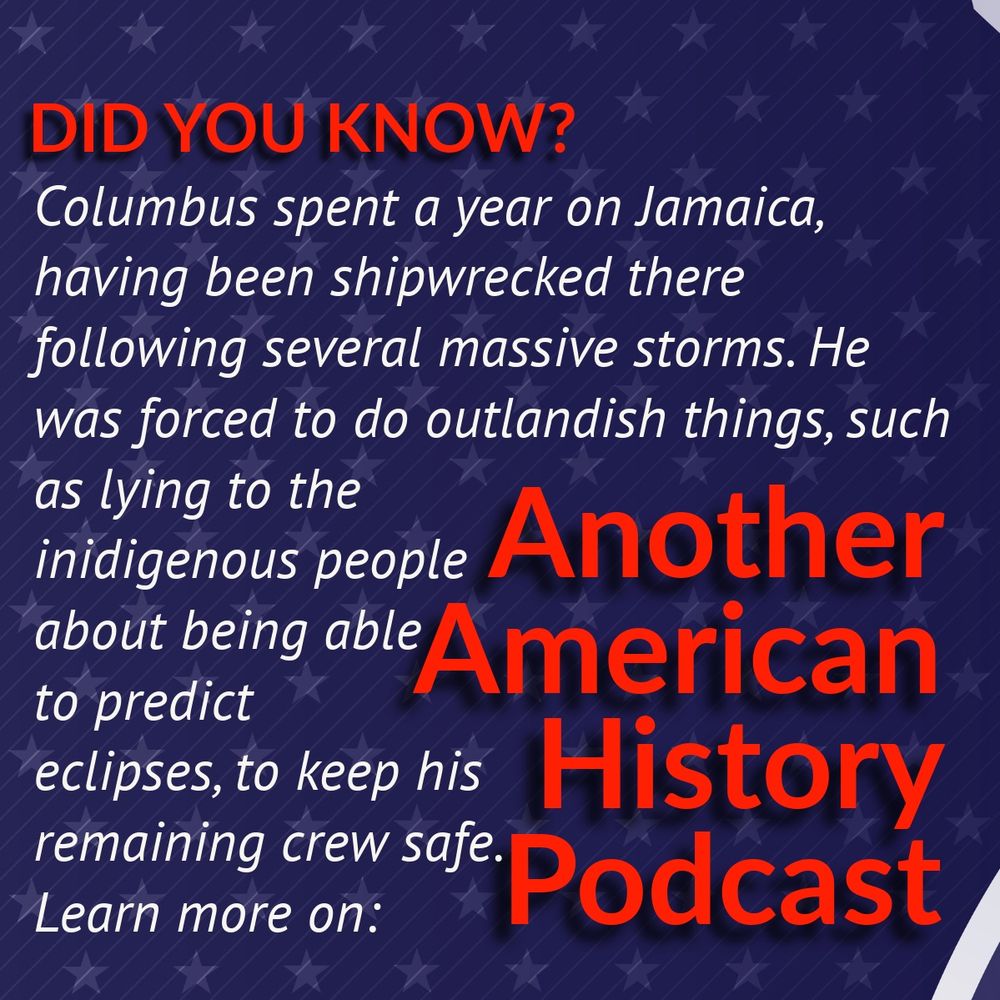
A DYK about Columbus’ time stranded on Jamaica and his lies to the natives to stay alive
And this was AFTER he’d already been arrested and released by the Spanish for his barbaric behavior in the Americas.
#columbus #indigenous #jamaica #colonization #history #americanhistory
The battle lasted for 5 weeks, and saw some of the bloodiest action of the war, with an estimated 21,000 Japanese forces killed, and another 7,000 Marines.
#dyk #thisdayinhistory #iwojima #ww2 #americanhistory #history
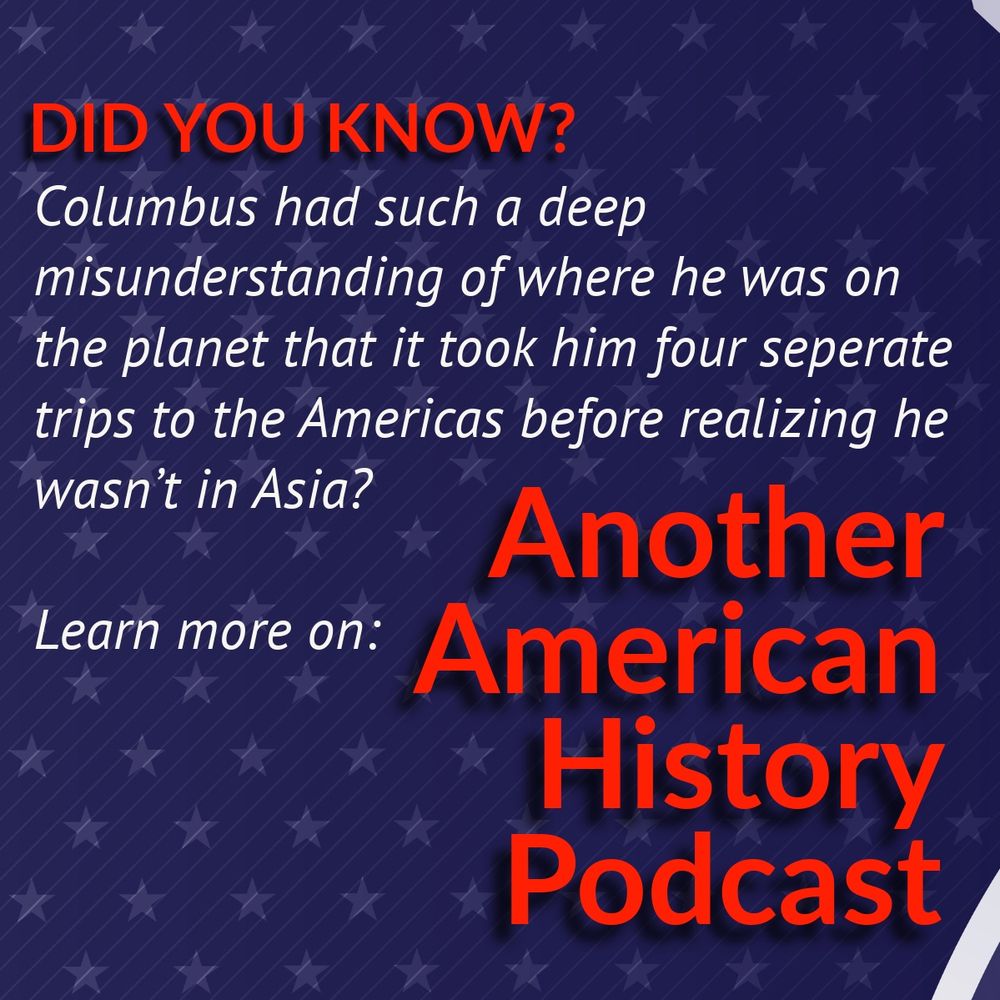
A DYK about Columbus’ inability to tell where he was on the planet despite having spent his life as a sailor
He really wasn’t the brightest.
#columbus #columbusday #history #americanhistory

A photo of George Bush, African American pioneer and settler
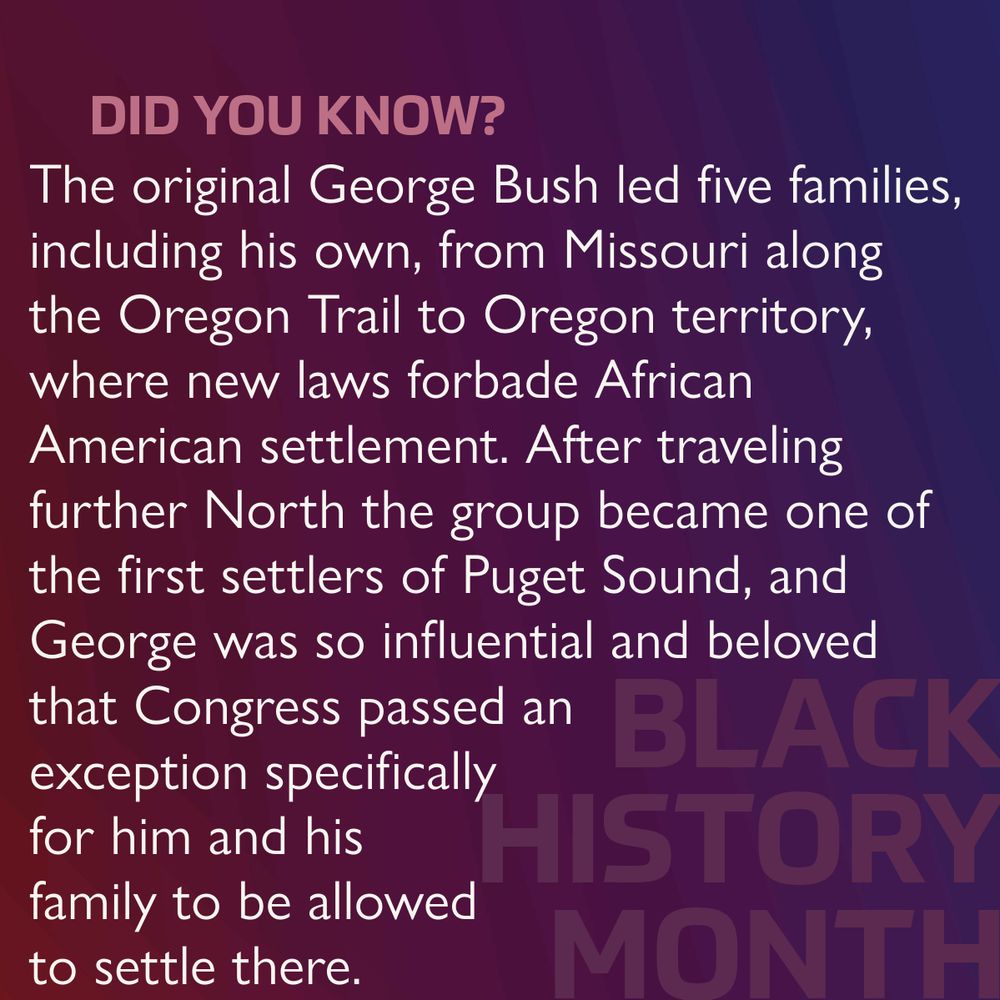
A DYK post about George Bush and his leadership along the Oregon Trail
Anyway here’s the post Facebook deemed inappropriate for their platform for violating their rules on “social issues”. So much for free speech
15.02.2025 20:18 — 👍 1 🔁 1 💬 0 📌 0
A DYK post about how Jackie Robinson was not the first black man to play in American Major League Baseball
#jackierobinson #mlb #majorleaguebaseball #history #americanhistory
10.02.2025 17:35 — 👍 1 🔁 0 💬 0 📌 0
A DYK about the Tuskegee Airmen
#tuskegee #tuskegeeairmen #blackhistory #blackhistorymonth #history #americanhistory
06.02.2025 18:16 — 👍 0 🔁 0 💬 0 📌 0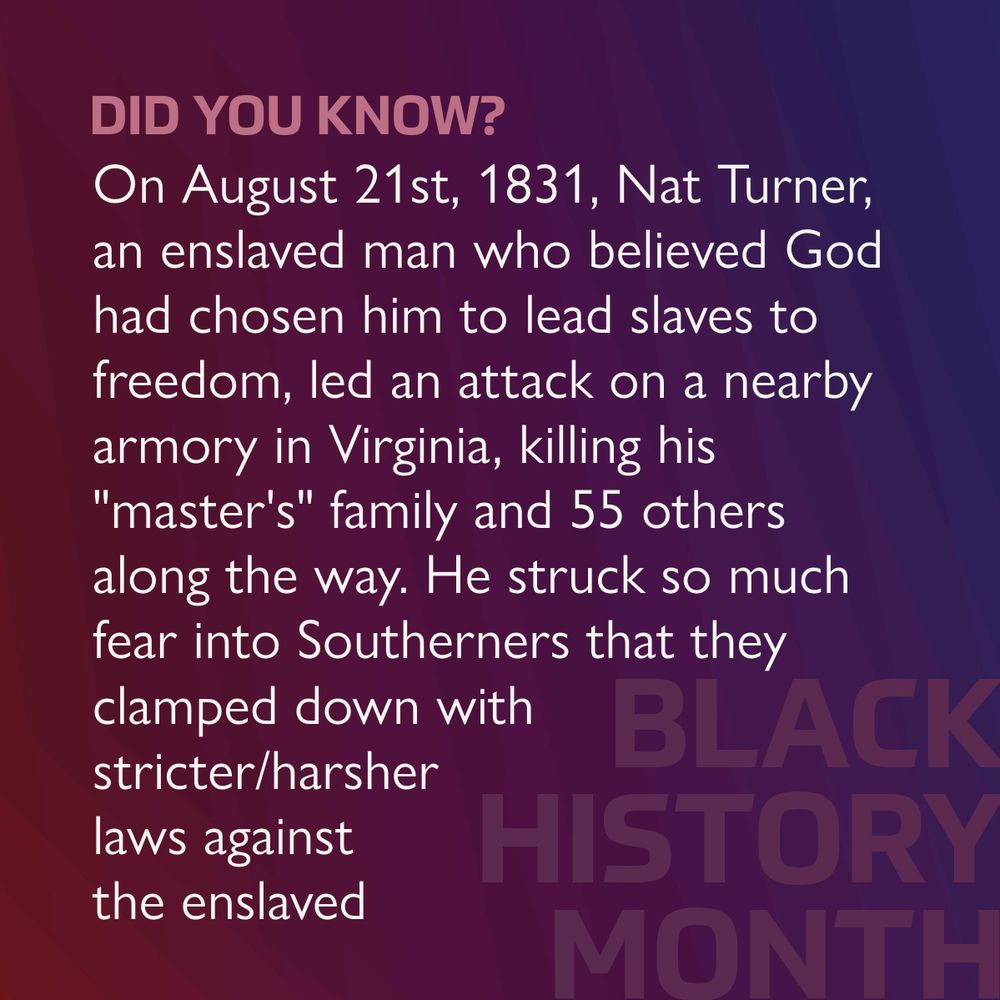
A DYK about Nat Turner and his slave revolt
#dyk #didyouknow #blackhistory #blackhistorymonth
04.02.2025 13:54 — 👍 3 🔁 0 💬 0 📌 0
A “did you know” post
#blackhistory #blackhistorymonth #americanhistory #history #podcast #historypodcast
03.02.2025 19:28 — 👍 1 🔁 0 💬 0 📌 1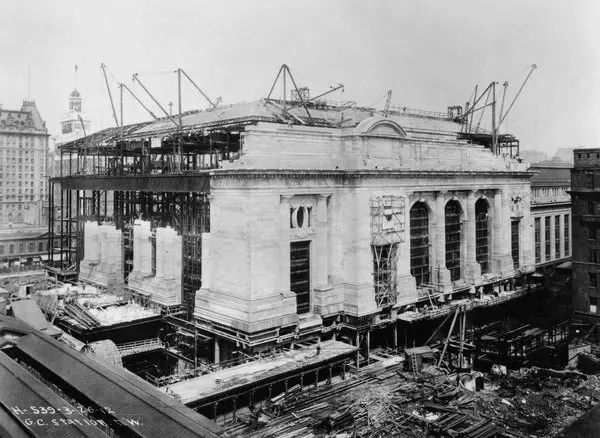
The Construction of Grand Central Terminal (1905-1913) This black-and-white historical photograph captures Grand Central Terminal in New York City during its construction phase, showcasing its Beaux-Arts architectural style. The grand building, still skeletal, is surrounded by scaffolding, cranes, and construction materials, demonstrating the ambitious scale of the project. The image highlights the transformation of transportation infrastructure in the early 20th century, as the station was designed to accommodate the growing demand for rail travel and electrification. Prior to the terminal’s construction, the site was home to Grand Central Depot (opened in 1871) and later Grand Central Station (1899), which was partially demolished to make way for this vastly expanded structure. The new terminal was designed by the firms Reed & Stem and Warren & Wetmore, featuring a monumental façade, large arched windows, and intricate detailing that exemplified the grandeur of the City Beautiful movement. The construction process required an immense workforce, as workers carved out vast underground spaces for train platforms and waiting areas. Grand Central Terminal was built with modern engineering innovations, including electrified tracks, a two-level concourse system to separate incoming and outgoing trains, and an extensive network of tunnels that would redefine how people traveled through the city. This image encapsulates the meticulous efforts of builders and architects who shaped one of the most iconic train stations in the world. Upon completion in 1913, the station would become the largest in the world, revolutionizing passenger rail service. The construction of Grand Central was part of a broader wave of urban modernization, symbolizing the rise of New York as a global metropolis and serving as a gateway to the nation’s expanding railway network.

Excavation and Rail Infrastructure Development at Grand Central This black-and-white photograph captures the massive excavation and infrastructure work undertaken during the construction of Grand Central Terminal. The image showcases a vast trench filled with railway tracks, partially constructed platforms, cranes, and workers engaging in complex engineering efforts to transform the site into one of the world’s most advanced transportation hubs. Before the terminal’s reconstruction, this area was home to steam locomotives, which created heavy pollution, noise, and congestion. The electrification of train lines required digging deep underground to accommodate a revolutionary two-level train system. This photograph reveals the significant demolition and earthmoving that took place to replace outdated facilities with a modern, efficient network. The image highlights the transition from steam power to electric railways, a major innovation of the time, allowing trains to operate within enclosed urban environments without producing smoke. By constructing tunnels and electrified rail lines, New York Central Railroad aimed to create a more organized and efficient railway system, enhancing commuter experience. The complexity of the construction process is evident in the unfinished tracks and exposed earth, demonstrating the immense scale of the undertaking. As part of this project, entire city blocks were excavated, requiring thousands of workers and years of labor. By the time Grand Central Terminal opened in 1913, it was not only the largest train station in the world but also a model for future transportation infrastructure projects. This image represents an era of grand engineering feats, where urban planning and technological advancements converged to redefine travel in the United States.
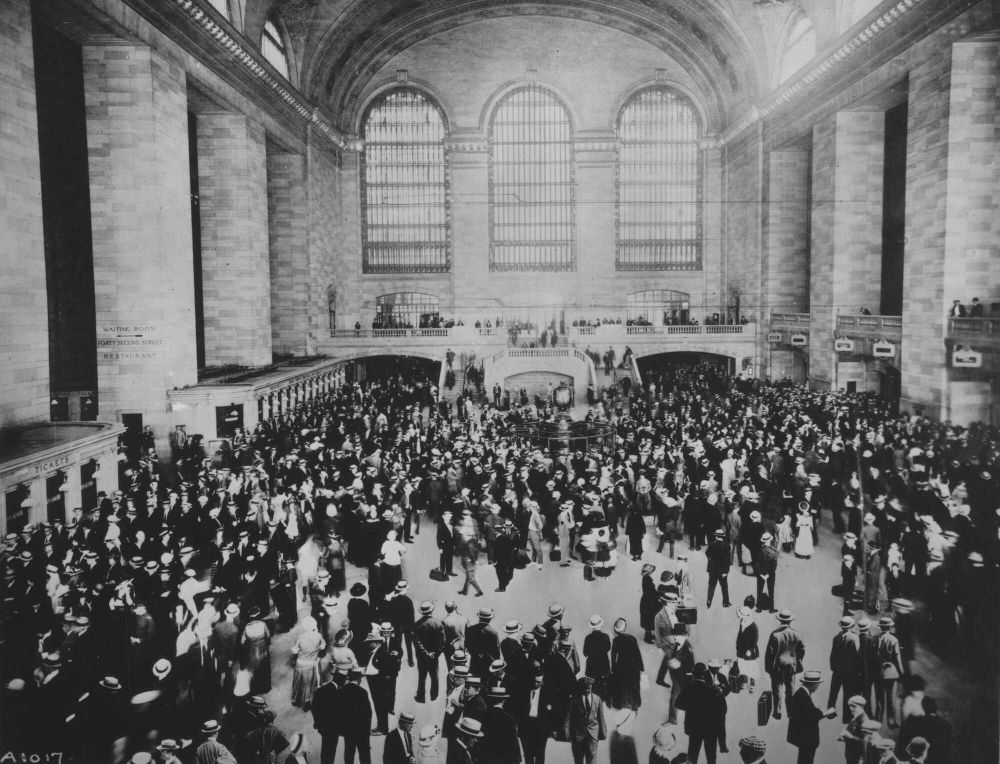
The Grand Opening of Grand Central Terminal (1913) This black-and-white historical photograph captures the bustling main concourse of Grand Central Terminal on its opening day, February 2, 1913. A sea of men and women, dressed in early 20th-century attire, fills the vast hall, highlighting the station’s immediate significance as a transit hub. The grandeur of the terminal’s Beaux-Arts design is on full display, with towering windows flooding the space with natural light, massive stone columns lending an air of classical elegance, and a mezzanine level overlooking the throngs of passengers below. The ticket booths lining the lower walls indicate the high demand for rail travel at the time, as passengers eagerly await their journeys. Designed to handle over 100,000 passengers daily, Grand Central quickly became a symbol of modern transportation and urban sophistication. The station’s opening marked a turning point in New York City’s development, integrating long-distance rail with local transit options. In addition to its function as a transportation hub, Grand Central Terminal was an architectural marvel, with an opulent celestial ceiling in the main concourse featuring constellations in gold leaf against a deep blue background. This image captures a moment in history when New Yorkers and visitors alike marveled at the station’s scale and efficiency. The station’s opening was widely celebrated, solidifying its place as one of the most important railway terminals in the world. Over a century later, Grand Central remains a cultural landmark, connecting millions of people to the heart of Manhattan and preserving its legacy as an icon of early 20th-century infrastructure.

Grand Central Terminal in the 21st Century This vibrant, full-color photograph captures the modern-day Grand Central Terminal, highlighting its architectural splendor and ongoing relevance in New York City’s transportation network. The image showcases the station’s iconic celestial ceiling, adorned with a mural of the zodiac constellations, painted in 1912 and restored in the 1990s. American flags hang proudly from the vaulted ceiling, a reminder of the station’s resilience and cultural significance, particularly following the events of 9/11 when Grand Central served as a vital transit point for thousands of commuters. The main concourse is filled with blurred figures in motion, illustrating the constant energy of the space, as hundreds of thousands of travelers pass through daily. The luminous chandeliers, large arched windows, and Beaux-Arts detailing provide a striking contrast between the historic past and the dynamic present. Since its opening in 1913, Grand Central has endured economic shifts, near-demolition in the 1970s, and multiple restorations, emerging as a beloved landmark protected by historic preservation efforts led by figures like Jacqueline Kennedy Onassis. Today, the station is more than a transportation hub—it is a cultural institution, housing shops, restaurants, and public events. This image exemplifies the enduring beauty and functionality of Grand Central Terminal, a place where history and modernity intersect, continuing to serve as a gateway to New York City. Whether viewed as an architectural masterpiece or a crucial part of daily life for millions, Grand Central Terminal remains a testament to the city’s ambition and resilience.
On February 2, 1913, NYC’s Grand Central Terminal opened, becoming the world’s largest train station. Its Beaux-Arts design, celestial ceiling, and grand concourse made it an architectural icon, serving millions and shaping transportation history.
#StayCurious #Skystorians #DiveIntoDiscovery #NYC
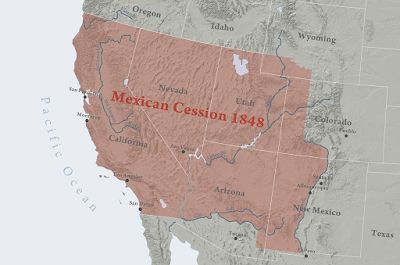
Map of the Mexican Cession (1848) This historical map illustrates the territorial changes resulting from the Treaty of Guadalupe Hidalgo, signed on February 2, 1848, marking the end of the Mexican-American War. The shaded area, labeled “Mexican Cession 1848,” represents the vast land—approximately 529,000 square miles—that Mexico ceded to the United States. This region, encompassing present-day California, Nevada, Utah, and parts of Arizona, Colorado, New Mexico, and Wyoming, significantly expanded U.S. territory and altered the geopolitical landscape of North America. Before the war, these lands were under Mexican sovereignty, with Spanish and Indigenous influences shaping the region’s history. The treaty formalized U.S. control, accelerating westward expansion under the ideology of Manifest Destiny, the belief that the United States was destined to spread from coast to coast. However, this acquisition fueled tensions over the expansion of slavery, intensifying sectional divides that would eventually lead to the Civil War. The treaty also promised protection of Mexican landowners’ rights, though many faced legal disputes and displacement in subsequent decades. The legacy of the Mexican Cession remains embedded in the cultural, demographic, and political identity of the southwestern U.S. today, where Hispanic and Indigenous heritage continues to shape the region. The map itself, a modern historical representation, highlights the borders imposed after the war, illustrating the dramatic territorial shift and the lasting impact of the 1848 treaty.
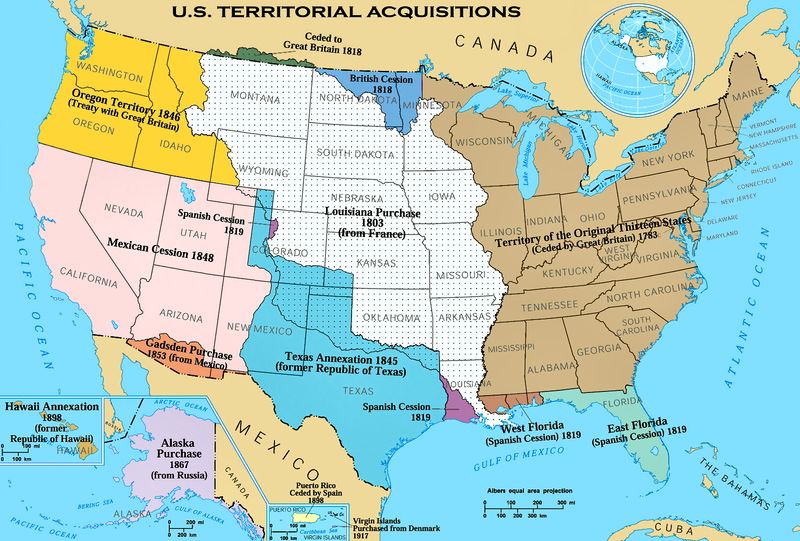
U.S. Territorial Expansion Map This color-coded historical map depicts the various territorial acquisitions that shaped the United States, with a particular emphasis on the Mexican Cession of 1848 following the Treaty of Guadalupe Hidalgo. The Mexican Cession is shaded in light brown, indicating the land ceded by Mexico. Other major land acquisitions, including the Louisiana Purchase (1803), Texas Annexation (1845), and Gadsden Purchase (1853), are labeled, visually demonstrating how the U.S. expanded westward over the 19th century. The map provides context for U.S. expansionism, showing how the nation’s borders evolved through diplomatic agreements, purchases, and conflicts. The Mexican-American War, which preceded the 1848 treaty, was fueled by disputes over Texas and President James K. Polk’s aggressive expansionist policies. The Gadsden Purchase (1853), just south of the Mexican Cession, was later acquired to facilitate railroad development. This map also reflects how Native American lands were gradually seized, a process that led to widespread displacement. The Treaty of Guadalupe Hidalgo, while marking the end of U.S.-Mexico conflict, left a lasting impact on Mexican-American communities, whose land rights and citizenship were often challenged in the decades following the treaty’s signing. This visual representation underscores the U.S.’s territorial ambition, its conflicts with neighboring nations, and the long-term consequences for Indigenous and Hispanic communities.
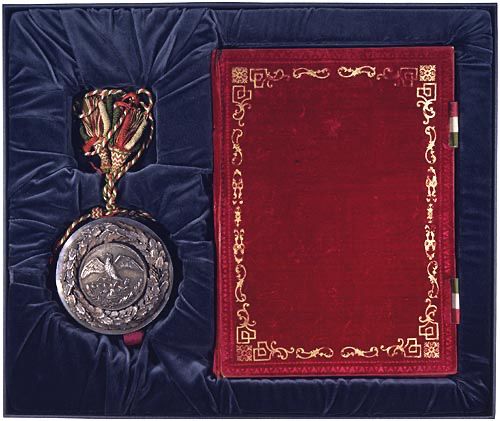
Treaty of Guadalupe Hidalgo (Medal & Treaty Book) This photograph displays the official treaty document of the Treaty of Guadalupe Hidalgo (1848), alongside a commemorative medal, symbolizing the agreement that ended the Mexican-American War. The treaty, signed on February 2, 1848, led to the U.S. acquisition of California, Nevada, Utah, and parts of several other states. The red, gold-embossed book contains the treaty’s text, which formalized peace between Mexico and the United States, though it carried long-lasting consequences for territorial governance, citizenship rights, and property ownership in the newly acquired regions. The ornate silver medal, adorned with an eagle and intricate engravings, signifies the diplomatic weight of the treaty. At the time, the agreement required Mexico to cede over half of its national territory in exchange for $15 million, a sum meant to compensate for damages inflicted during the war. Despite provisions guaranteeing land and civil rights to Mexican citizens remaining in the U.S., many lost their property due to legal loopholes and Anglo-American land claims. This artifact, now preserved as a historical relic, serves as a testament to diplomacy, conquest, and the complex legacies of U.S. expansionism, as well as the challenges Mexican-Americans faced in preserving their heritage and identity in a newly defined political landscape.
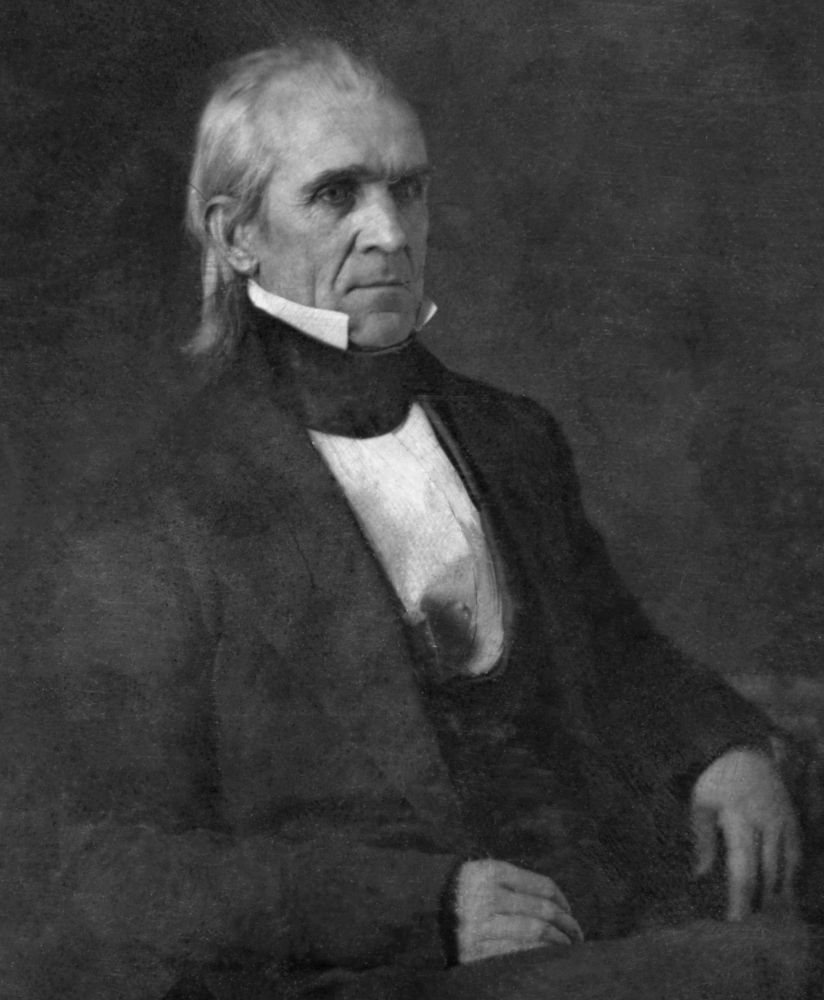
Portrait of James K. Polk: Architect of American Expansion (1845-1849) This black-and-white portrait features James K. Polk, the 11th President of the United States (1845–1849), a leader whose expansionist policies played a crucial role in shaping American history. Polk, a staunch proponent of Manifest Destiny, aggressively pursued territorial expansion, a vision that culminated in the Mexican-American War (1846–1848) and the Treaty of Guadalupe Hidalgo on February 2, 1848. Under this treaty, the U.S. acquired California, Arizona, New Mexico, Utah, Nevada, and parts of Colorado and Wyoming, dramatically reshaping the continent’s geopolitical landscape. Polk’s presidency was defined by his commitment to expansion, fulfilling his campaign promises to annex Texas (1845), secure the Oregon Territory (1846), and acquire vast lands from Mexico. His negotiations with Britain resolved the Oregon boundary dispute, avoiding conflict with the British Empire while focusing military efforts on Mexico. His decision to send General Zachary Taylor to the disputed Texas-Mexico border provoked war, a conflict Polk justified as a response to Mexican aggression. However,his war efforts were controversial, with critics, including Abraham Lincoln and Henry David Thoreau, condemning them as unjust aggression to expand slavery into the West. Here, Polk appears stern and resolute, in formal 19th-century attire, reflecting the serious demeanor and determination that defined his presidency. His tenure remains one of the most consequential in U.S. history, as his territorial acquisitions paved the way for future conflicts over slavery, including the Compromise of 1850 and the Civil War (1861–1865). Though he achieved his expansionist goals, he declined to seek re-election and died just three months after leaving office in 1849. His legacy, embodied in the Treaty of Guadalupe Hidalgo, continues to influence American-Mexican relations, Indigenous rights, and debates over territorial conquest.
On February 2, 1848, the Treaty of Guadalupe Hidalgo ended the Mexican-American War, ceding vast territories (incl. CA, AZ & NM) to the U.S. This reshaped North America’s borders,fueling westward expansion and future conflicts over slavery and land rights
#StayCurious #Skystorians #DiveIntoDiscovery
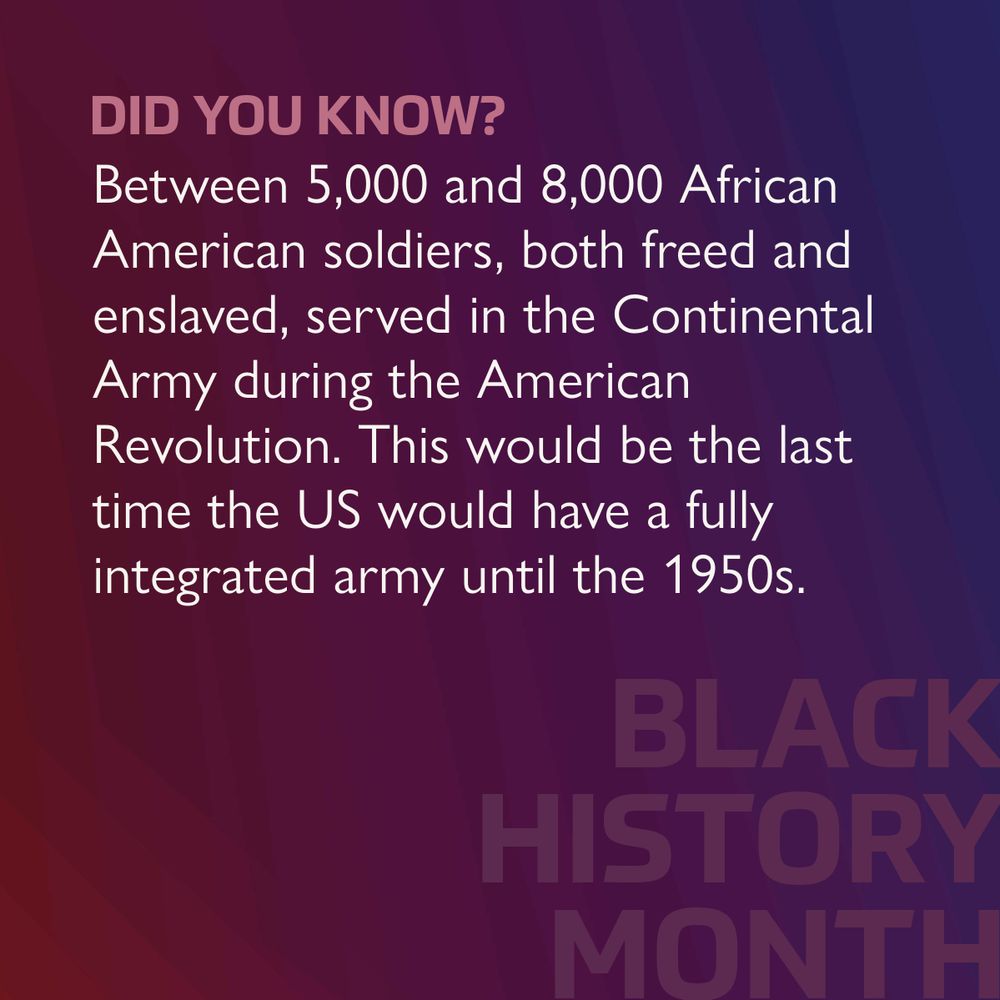
A “did you know?” Post saying that between 5,000 and 8,000 African American soldiers served in the continental army during the revolution, being the only fully integrated US army until the 1950s
#blackhistory #blackhistorymonth #americanhistory #history
02.02.2025 20:24 — 👍 0 🔁 0 💬 0 📌 0
A poster advocating for AAHP Ep. 2
New episode out now! #columbus #history #America #americanhistory
02.02.2025 20:22 — 👍 0 🔁 0 💬 0 📌 0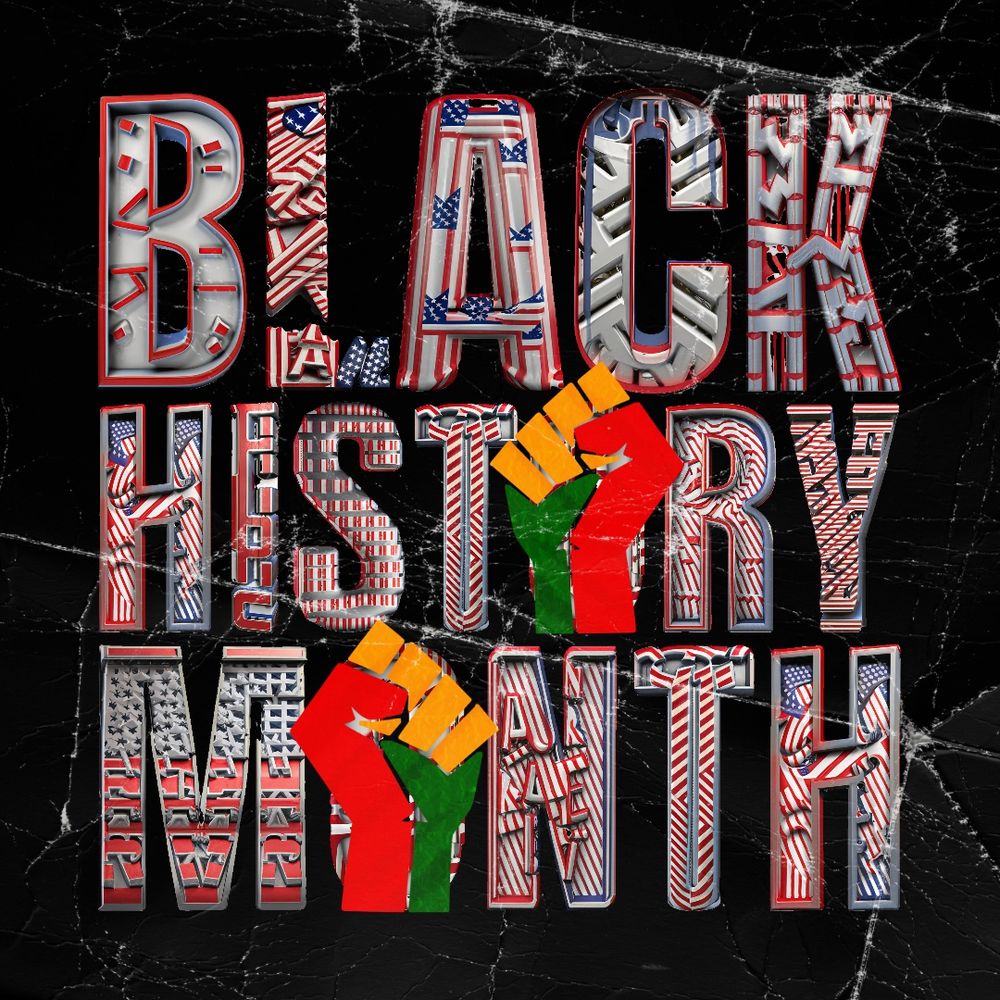
A black history month post
Join us at AAHP as we celebrate Black History Month
02.02.2025 20:22 — 👍 0 🔁 0 💬 0 📌 0#martinlutherkingjr #mlk #mlkjr #martinlutherking
20.01.2025 14:34 — 👍 1 🔁 0 💬 0 📌 0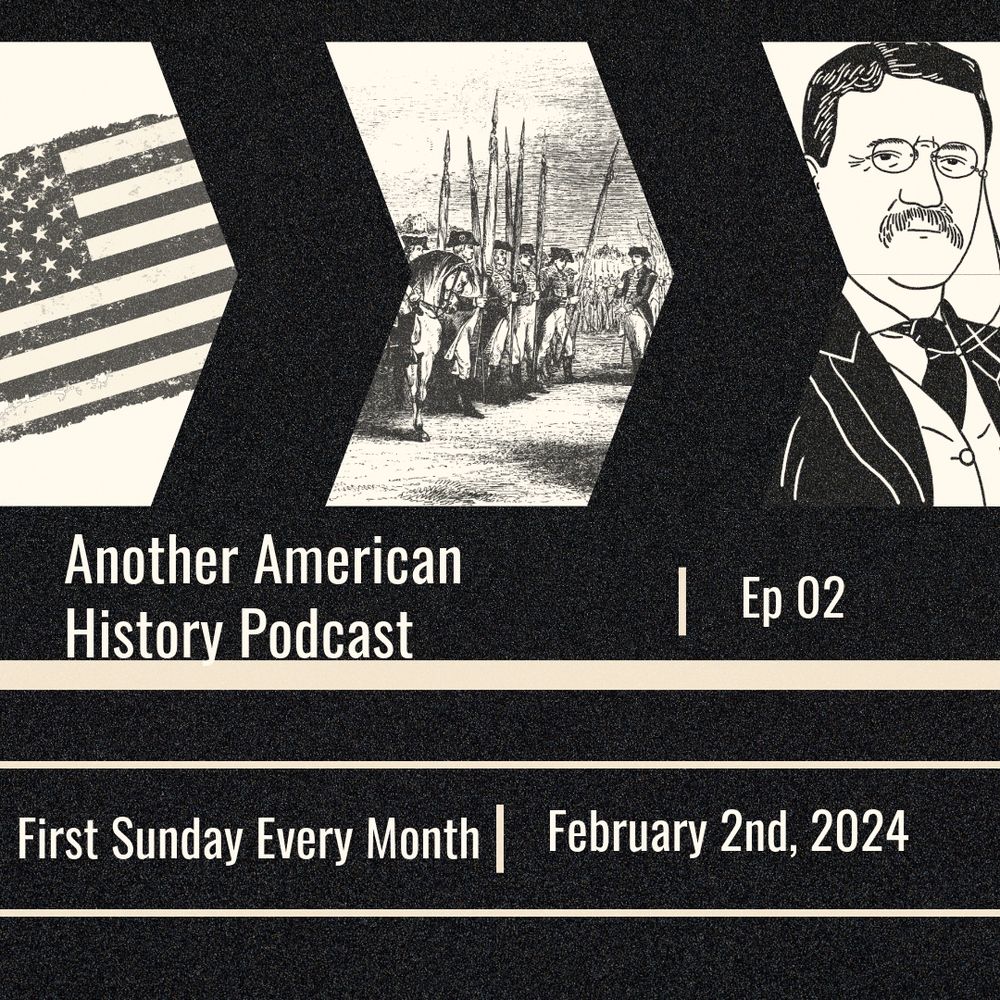
A poster with updates on when new episodes of AAHP will be posted
Thank you to everyone’s who’s joined us so far!
17.01.2025 17:46 — 👍 2 🔁 0 💬 0 📌 2Fair enough, never take on more than you can handle. We’re just huge fans!
15.01.2025 16:02 — 👍 1 🔁 0 💬 1 📌 0Do you think the games will ever be merged?
15.01.2025 15:56 — 👍 1 🔁 0 💬 1 📌 0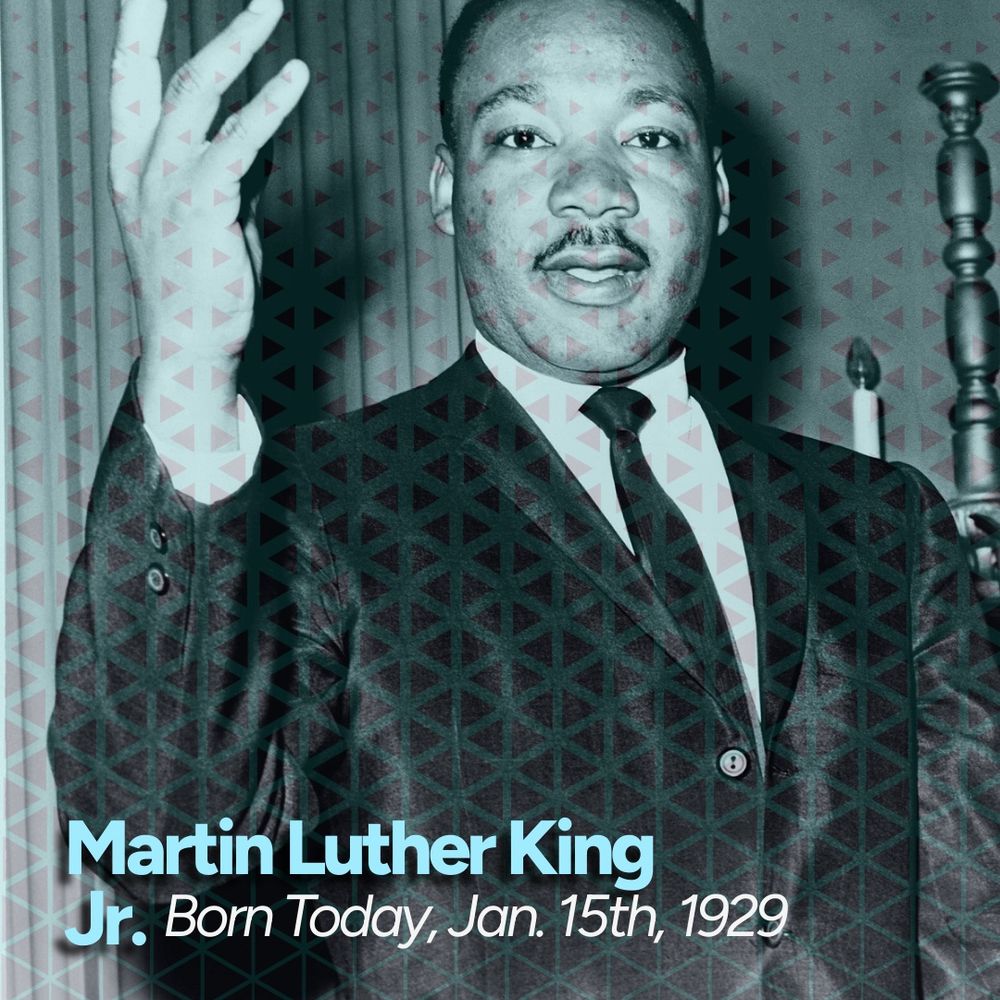
A photo of Martin Luther King Jr. with his birthdate and name underneath
#dyk: Today in 1929, the influential and dedicated civil rights leader Martin Luther King Junior was born. He would go on to be one of the most outspoken and recognizable voices in the civil rights movement before his assassination in 1968. #martinlutherking #mlk #mlkjr #history #americanhistory
15.01.2025 15:54 — 👍 2 🔁 1 💬 0 📌 0#history #americanhistory #podcast #historypodcast
14.01.2025 15:55 — 👍 2 🔁 0 💬 0 📌 0
A “Did you know” post stating that Columbus was so incompetent and violent during his reign in the America’s that Spain had him arrested, stripped of his titles, and shipped back to Spain in chains
#history #Columbus #podcast #historypodcast #columbusday
13.01.2025 19:10 — 👍 3 🔁 0 💬 0 📌 1